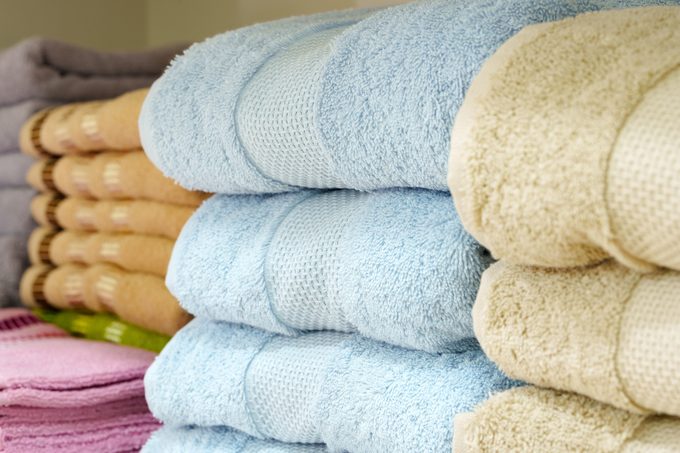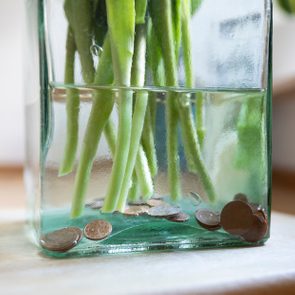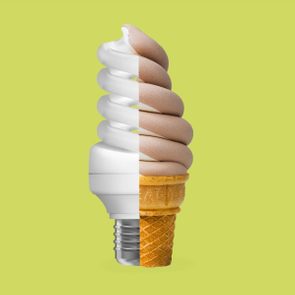It turns out, your towels have been keeping a secret—and it's all in the strips

Here’s Why Bathroom Towels Have Those Woven Strips on Both Ends

You use a bathroom towel every day, possibly multiple times a day. Sure, you grab one after your shower, but you’ve probably also reached for one in a pinch to sop up a mess (those dirty pet prints aren’t going to clean up themselves) or to take to the pool or beach (a towel is a towel, right?).
Bathroom towels are catchall for just about anything, and that hasn’t gone ignored by those who make them. While their colors and patterns may be just for show, their construction has a far more functional purpose. Take those woven strips on both ends. Ah, now you notice them. But why are they there?
Once you realize that most bathroom towels have this feature, it’s hard to stop wondering about it. Well, lucky for you, we have the answer below. Read on to find out!
Get Reader’s Digest’s Read Up newsletter for more fun facts, humor, cleaning, travel and tech all week long.
Why do towels have these woven strips?
The short answer to this trivia tidbit is that they make towels more durable. Most bathroom towels are made of terry fabric, which has a porous weave for optimal water absorption and softness. “When you are designing products with terry, which has loosely stacked pile or threads, fraying is more likely,” says Alexa Raab, the director of communications for CovationBio Sorona, a manufacturer of partially plant-based polymer used in bathroom towels. To curb that potential fraying, manufacturers create strips with a dense weave on both ends of the towels for edge reinforcement.
“So you get the softness and absorbency that you look for in a towel, without the risk of it losing its shape or shrinking,” says Raab. “Otherwise, given that terry weave is open on both sides with uncut piles, your towel just won’t last. The strips really prolong the life of your towel, especially ones that get washed a lot.”
To look at it another way, think of the woven strips like hair scrunchies: They are made to reinforce a style and keep your hair from wisping away. “Envision the bubble braid style that’s popular right now, with a high ponytail and another hair tie at the middle or end of the hairstyle. This is done to keep the look nice and tight,” says Raab.
Do all towels have this feature?

Woven strips on the ends of bathroom towels have gone in and out of fashion over the last 100-plus years, so this answer largely depends on the origin of your towel—and where it was intended for use.
The history of the strips goes back further than you might think: With the invention of the dobby loom in 1843, weavers began incorporating the strips on fabrics, calling them “dobby borders.” The name comes from the dobby loom, on which weavers use a special attachment to create simple, geometric patterns.
Towel manufacturers who sell to commercial users, like hotels or gyms, are more likely to add dobby borders. They add the durability needed for multiple industrial-scale washing-machine cycles. Yet you’re likely to find them in the bed and bath department of your local Target or Walmart as well, since they’re considered a mark of quality and cost a bit more than towels without them.
Towels made by popular brands like Frontgate, Brooklinen and Land’s End have these strips.
Are towels with these strips better than towels without them?
It all comes down to how long you’d like your towels to last. Knowing that strips provide more durability and longevity, they appeal to those looking to buy less and reuse more.
“As a society, we’re moving toward a place where we’re thinking about sustainability more and want things to last longer,” says Raab. “[Our engineers] talk a lot about the circular economy—decreasing the amount of fabric that enters the waste stream. The ability for a towel to not shrink and still feel nice after multiple washings is a big move toward that.”
How can you tell if a towel like this is well made?
Having these woven strips certainly helps, but well-made towels have a few other features in common too:
- It doesn’t fray after multiple washings.
- It absorbs water quickly and efficiently.
- It dries quickly.
- It has secure and neat stitching.
- It offers natural softness that doesn’t “wear off” in the wash.
It’s an added bonus if the hang tag on the towel offers the distinction of eco-conscious fabrication. “There’s a lot being said now for traceability and transparency, especially when it comes to biomaterials,” says Raab. “Look for towel tags that offer material origins, and if it’s important to you, go on online and learn more about those materials.”
When might you want a towel without these strips?
If you know you’re only going to use your towel once, perhaps to clean up a particularly bad stain or mess, you could go with a lower-priced option that isn’t made for the long run. Or if you just really like the look of a towel for, say, a guest bathroom, who are we to stand in the way of your aesthetic tastes?
Ultimately, the best towel is one that meets your personal needs and preferences in terms of softness, absorbency and durability. And knowing that bath towels have a way of going wherever life takes you, from shower mat to beach chair to gym locker, consider them an investment that goes beyond your bathroom walls.
About the expert
|
Why trust us
At Reader’s Digest, we’re committed to producing high-quality content by writers with expertise and experience in their field in consultation with relevant, qualified experts. We rely on reputable primary sources, including government and professional organizations and academic institutions as well as our writers’ personal experiences where appropriate. We verify all facts and data, back them with credible sourcing and revisit them over time to ensure they remain accurate and up to date. Read more about our team, our contributors and our editorial policies.
Sources:
- Alexa Raab, director of communications for CovationBio Sorona; interviewed, April 2025



